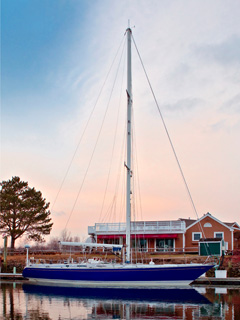 story by Kirsten HarperMy boyfriend had always wanted to live aboard, so when he went to school to learn how to build wooden sailboats it seemed an opportune time to begin this adventure. We learned how to sail from scratch and bought a used, 30-year-old boat for a bargain during the height of the recession. When we moved out of our apartment in May 2010, I knew we’d be learning to live very differently. After donating all our furniture and many of our non-essential earthly possessions to friends and Goodwill, I was prepared to get by with less stuff. What I didn’t anticipate was the new way we’d come to view our resources.
story by Kirsten HarperMy boyfriend had always wanted to live aboard, so when he went to school to learn how to build wooden sailboats it seemed an opportune time to begin this adventure. We learned how to sail from scratch and bought a used, 30-year-old boat for a bargain during the height of the recession. When we moved out of our apartment in May 2010, I knew we’d be learning to live very differently. After donating all our furniture and many of our non-essential earthly possessions to friends and Goodwill, I was prepared to get by with less stuff. What I didn’t anticipate was the new way we’d come to view our resources.
Nothing is automatic about living on a boat; everything must be brought in, refilled and checked for levels. It’s a totally different reality than living on land, where one is fully plugged in to a seemingly endless supply of water and energy. The average indoor water usage for an American is 69.3 gallons per day, with 11.6 gallons used for showers, 15 gallons for washing machines and 18.5 gallons for toilets. In our floating, low-impact home, we average about eight gallons per day, not counting clothes-washing, which is done on land. Boat toilets use very little water, and showers involve a handheld showerhead that is only “on” when a button is pressed, which helps prevent overuse. With a water capacity of 250 gallons stored in three tanks below the floorboards, anyone would think twice before letting the water run. After all, we’re personally responsible for the chore of filling the tanks again when they sputter to a disappointing drip. During guest visits, we can see ourselves two years ago, taking long showers with abandon and letting the water run when we wash our hands or brush our teeth. When guests are gently reminded that water isn’t endless aboard our ship, you can see that this is the first time they’ve contemplated the possibility of a limit. It makes us realize how much we’ve changed.
Our power usage has gone down, too, with an average consumption of about 60 to 70 kilowatt hours per month, and 288 kwh more in the winter when we use an electric heater. Overall, that’s about five to 10 percent of what an average American household consumes. We have LED lights, which use much less power than conventional bulbs, our refrigerator is a small drawer style unit, and in the cold months we battle the chill with a kerosene heater used only in the room we’re spending time in. We also sleep with a lower ambient air temperature, opting for more blankets instead.
Summertime offers some very different challenges to boat living, namely beating the heat. After some oppressive days during our first summer aboard, we learned to string up a large canvas canopy over the deck to protect us from direct sunlight and keep cooler breezes moving over the deck. Open hatches and a few well-placed fans also help keep it livable.
But we get the most direct, satisfying sense of conservation when we take our home out for a spin. Once the channel in the north Chesapeake has opened a bit, we put up the sails and cut the engine. The only sounds left are the boat’s bow cutting through the waves and the lines creaking and tightening as a gust of wind fills the sails. The hull of our ketch rig heels over gradually as a new balance is established and we charge ahead, all 50,000 pounds of fiberglass, wood, tanks full of water and diesel, batteries, a generator, equipment and all our belongings. Everything is pulled by the wind at a comfortable clip, leaving nothing but a smooth line in the water behind us.
Kirsten Harper is an illustrator, designer and frequent contributor to Grid. To see some of her work, visit kirstenharper.com. To read more about her adventures at sea, visit kirstenharper.squarespace.com/blog/category/sailing







Great article! Still thankful that all went well. Thanks for sharing! http://www.yachts4fun.com
Great article! Still thankful that all went well. Thanks for sharing! http://www.yachts4fun.com